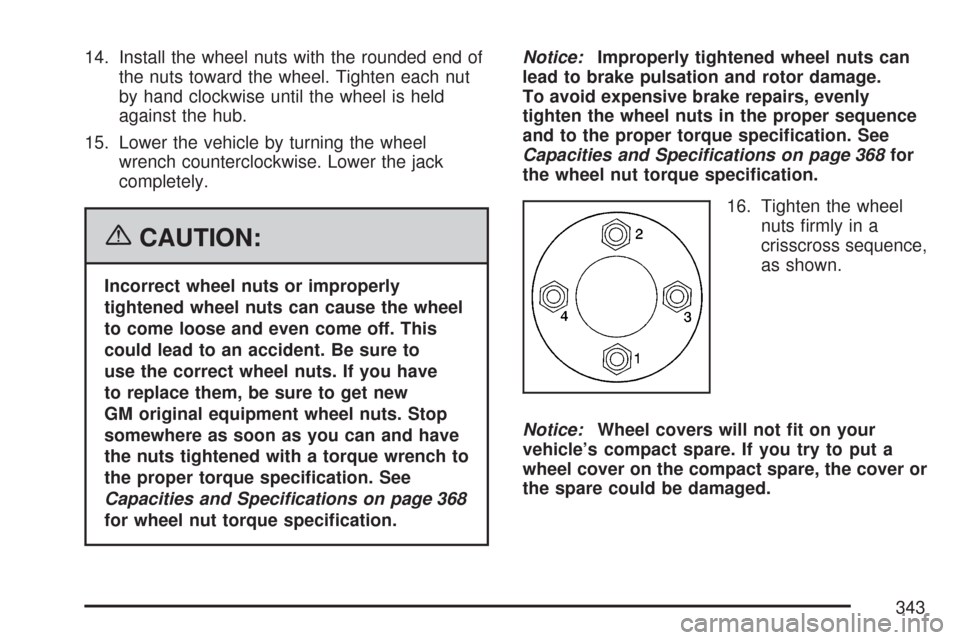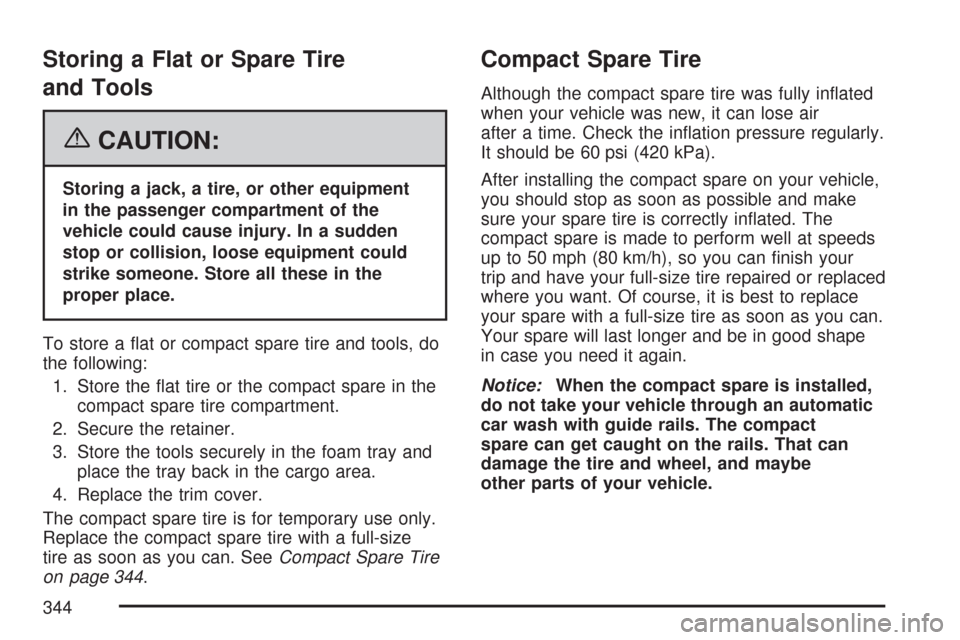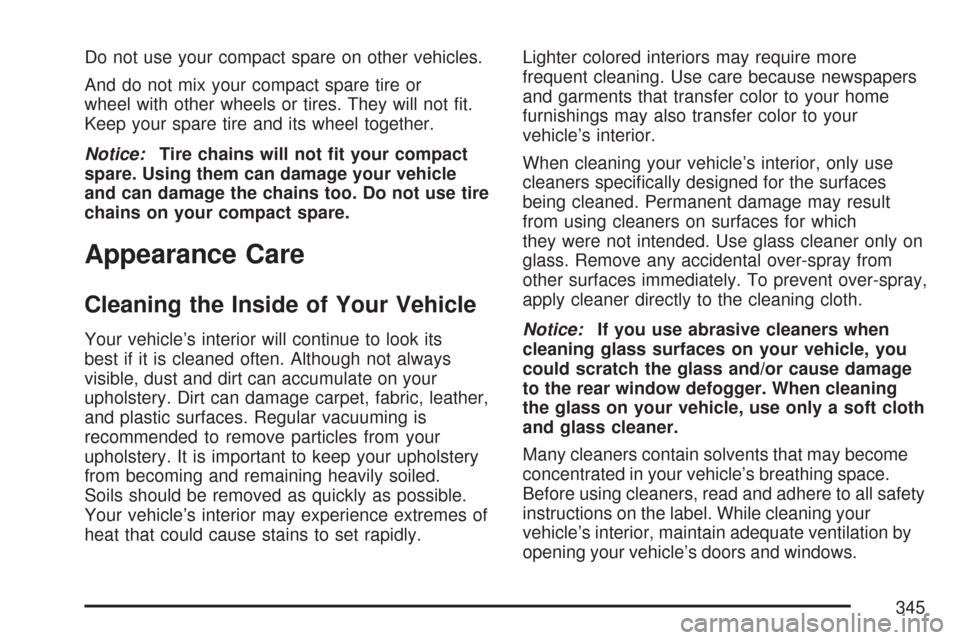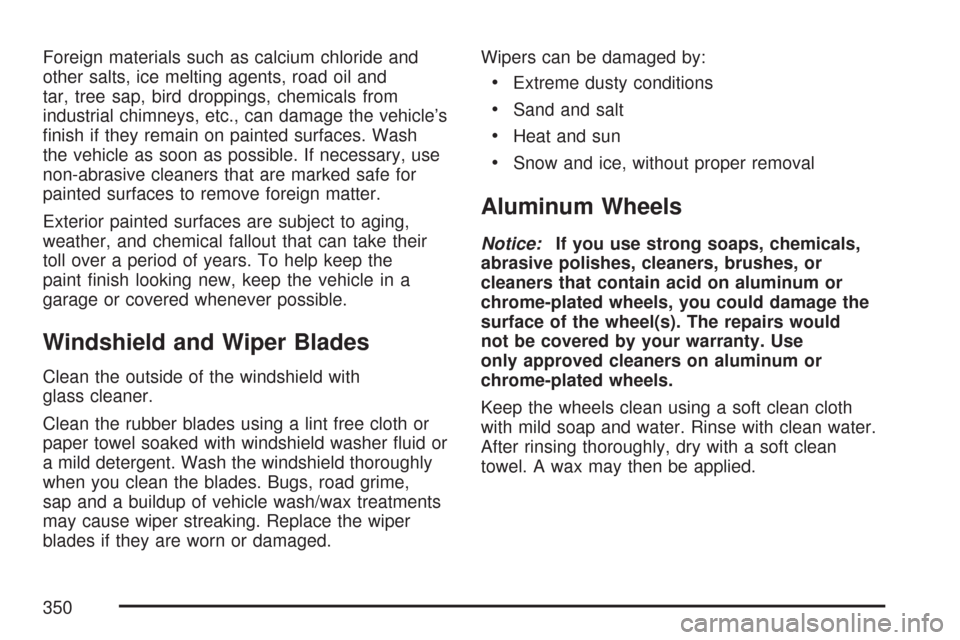Page 339 of 436
Removing the Flat Tire and
Installing the Spare Tire
1. It is recommended that you do a safety check
before preceding. SeeChanging a Flat Tire
on page 336for more information.
2. If your vehicle has wheel covers, loosen the
four plastic caps by hand or by using the
wheel wrench. The plastic nuts do not come
off of the cover.
3. Remove the wheel cover using the flat end of
the jack handle. Pry along the edge of the
wheel cover until it comes off.
Store the wheel cover in the cargo area until
you have the flat tire repaired or replaced.4. Use the wheel wrench to loosen all the wheel
nuts. Do not remove them yet.
339
Page 340 of 436
5. Locate the notch in the frame near each
wheel which the jack head fits in.
6. Position the jack and raise the jack head until
it fits firmly into the notch in the vehicle’s
frame nearest the flat tire.
7. Put the compact spare tire near you.
HatchbackSedan
340
Page 341 of 436
8. Insert the jack handle into the jack and the
wheel wrench onto the end of the jack handle.
{CAUTION:
Getting under a vehicle when it is jacked
up is dangerous. If the vehicle slips off
the jack you could be badly injured or
killed. Never get under a vehicle when it is
supported only by a jack.
{CAUTION:
Raising your vehicle with the jack
improperly positioned can damage the
vehicle and even make the vehicle fall. To
help avoid personal injury and vehicle
damage, be sure to �t the jack lift head
into the proper location before raising
the vehicle.
9. Raise the vehicle by turning the wheel wrench
clockwise. Raise the vehicle far enough off
the ground so there is enough room for
the compact spare tire to fit underneath the
wheel well.
10. Remove all of the wheel nuts by turning them
counterclockwise.
11. Remove the flat tire.
341
Page 342 of 436
{CAUTION:
Rust or dirt on the wheel, or on the parts
to which it is fastened, can make the
wheel nuts become loose after time. The
wheel could come off and cause an
accident. When changing a wheel, remove
any rust or dirt from the places where the
wheel attaches to the vehicle. In an
emergency, a cloth or a paper towel can
be used to do this; but be sure to use a
scraper or wire brush later, if needed, to
get all the rust or dirt off.12. Remove any rust or
dirt from the wheel
bolts, mounting
surfaces and
spare wheel.
13. Place the compact spare tire on the
wheel-mounting surface.
{CAUTION:
Never use oil or grease on studs or nuts.
Because the nuts might come loose. The
vehicle’s wheel could fall off, causing a
serious accident.
342
Page 343 of 436

14. Install the wheel nuts with the rounded end of
the nuts toward the wheel. Tighten each nut
by hand clockwise until the wheel is held
against the hub.
15. Lower the vehicle by turning the wheel
wrench counterclockwise. Lower the jack
completely.
{CAUTION:
Incorrect wheel nuts or improperly
tightened wheel nuts can cause the wheel
to come loose and even come off. This
could lead to an accident. Be sure to
use the correct wheel nuts. If you have
to replace them, be sure to get new
GM original equipment wheel nuts. Stop
somewhere as soon as you can and have
the nuts tightened with a torque wrench to
the proper torque speci�cation. See
Capacities and Specifications on page 368
for wheel nut torque speci�cation.Notice:Improperly tightened wheel nuts can
lead to brake pulsation and rotor damage.
To avoid expensive brake repairs, evenly
tighten the wheel nuts in the proper sequence
and to the proper torque speci�cation. See
Capacities and Specifications on page 368for
the wheel nut torque speci�cation.
16. Tighten the wheel
nuts firmly in a
crisscross sequence,
as shown.
Notice:Wheel covers will not �t on your
vehicle’s compact spare. If you try to put a
wheel cover on the compact spare, the cover or
the spare could be damaged.
343
Page 344 of 436

Storing a Flat or Spare Tire
and Tools
{CAUTION:
Storing a jack, a tire, or other equipment
in the passenger compartment of the
vehicle could cause injury. In a sudden
stop or collision, loose equipment could
strike someone. Store all these in the
proper place.
To store a flat or compact spare tire and tools, do
the following:
1. Store the flat tire or the compact spare in the
compact spare tire compartment.
2. Secure the retainer.
3. Store the tools securely in the foam tray and
place the tray back in the cargo area.
4. Replace the trim cover.
The compact spare tire is for temporary use only.
Replace the compact spare tire with a full-size
tire as soon as you can. SeeCompact Spare Tire
on page 344.
Compact Spare Tire
Although the compact spare tire was fully inflated
when your vehicle was new, it can lose air
after a time. Check the inflation pressure regularly.
It should be 60 psi (420 kPa).
After installing the compact spare on your vehicle,
you should stop as soon as possible and make
sure your spare tire is correctly inflated. The
compact spare is made to perform well at speeds
up to 50 mph (80 km/h), so you can finish your
trip and have your full-size tire repaired or replaced
where you want. Of course, it is best to replace
your spare with a full-size tire as soon as you can.
Your spare will last longer and be in good shape
in case you need it again.
Notice:When the compact spare is installed,
do not take your vehicle through an automatic
car wash with guide rails. The compact
spare can get caught on the rails. That can
damage the tire and wheel, and maybe
other parts of your vehicle.
344
Page 345 of 436

Do not use your compact spare on other vehicles.
And do not mix your compact spare tire or
wheel with other wheels or tires. They will not fit.
Keep your spare tire and its wheel together.
Notice:Tire chains will not �t your compact
spare. Using them can damage your vehicle
and can damage the chains too. Do not use tire
chains on your compact spare.
Appearance Care
Cleaning the Inside of Your Vehicle
Your vehicle’s interior will continue to look its
best if it is cleaned often. Although not always
visible, dust and dirt can accumulate on your
upholstery. Dirt can damage carpet, fabric, leather,
and plastic surfaces. Regular vacuuming is
recommended to remove particles from your
upholstery. It is important to keep your upholstery
from becoming and remaining heavily soiled.
Soils should be removed as quickly as possible.
Your vehicle’s interior may experience extremes of
heat that could cause stains to set rapidly.Lighter colored interiors may require more
frequent cleaning. Use care because newspapers
and garments that transfer color to your home
furnishings may also transfer color to your
vehicle’s interior.
When cleaning your vehicle’s interior, only use
cleaners specifically designed for the surfaces
being cleaned. Permanent damage may result
from using cleaners on surfaces for which
they were not intended. Use glass cleaner only on
glass. Remove any accidental over-spray from
other surfaces immediately. To prevent over-spray,
apply cleaner directly to the cleaning cloth.
Notice:If you use abrasive cleaners when
cleaning glass surfaces on your vehicle, you
could scratch the glass and/or cause damage
to the rear window defogger. When cleaning
the glass on your vehicle, use only a soft cloth
and glass cleaner.
Many cleaners contain solvents that may become
concentrated in your vehicle’s breathing space.
Before using cleaners, read and adhere to all safety
instructions on the label. While cleaning your
vehicle’s interior, maintain adequate ventilation by
opening your vehicle’s doors and windows.
345
Page 350 of 436

Foreign materials such as calcium chloride and
other salts, ice melting agents, road oil and
tar, tree sap, bird droppings, chemicals from
industrial chimneys, etc., can damage the vehicle’s
finish if they remain on painted surfaces. Wash
the vehicle as soon as possible. If necessary, use
non-abrasive cleaners that are marked safe for
painted surfaces to remove foreign matter.
Exterior painted surfaces are subject to aging,
weather, and chemical fallout that can take their
toll over a period of years. To help keep the
paint finish looking new, keep the vehicle in a
garage or covered whenever possible.
Windshield and Wiper Blades
Clean the outside of the windshield with
glass cleaner.
Clean the rubber blades using a lint free cloth or
paper towel soaked with windshield washer fluid or
a mild detergent. Wash the windshield thoroughly
when you clean the blades. Bugs, road grime,
sap and a buildup of vehicle wash/wax treatments
may cause wiper streaking. Replace the wiper
blades if they are worn or damaged.Wipers can be damaged by:
•Extreme dusty conditions
•Sand and salt
•Heat and sun
•Snow and ice, without proper removal
Aluminum Wheels
Notice:If you use strong soaps, chemicals,
abrasive polishes, cleaners, brushes, or
cleaners that contain acid on aluminum or
chrome-plated wheels, you could damage the
surface of the wheel(s). The repairs would
not be covered by your warranty. Use
only approved cleaners on aluminum or
chrome-plated wheels.
Keep the wheels clean using a soft clean cloth
with mild soap and water. Rinse with clean water.
After rinsing thoroughly, dry with a soft clean
towel. A wax may then be applied.
350